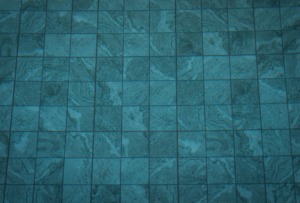The first time I ever heard of a saltwater pool, my mind immediately pictured my own swimming pool, but with rolling, sea-green water and foamy whitecaps, just like the ocean. Surely, I thought, this must be some newfangled way to purify your pool water without using chlorine.
Turns out I was wrong on most counts. Saltwater pools are by no means new. They first became popular in the United States more than 50 years ago after being introduced in New Zealand during the early 1970’s. No, the water isn’t sea-green, it doesn’t taste of salt, and you won’t float effortlessly atop it as if you were on the Dead Sea. And no, salt has not replaced chlorine as your pool’s most essential cleaning agent.
In fact, saltwater pools use chlorine to sanitize the water exactly like traditional freshwater pools do. The big difference is in how the chlorine is introduced into the pool.
For a traditional freshwater pool, you purchase the chlorine at your neighborhood pool store and add it as needed. For a saltwater pool, a special chlorine generator converts sodium chloride (NaCl, or basic table salt) into chlorine. These generators—more commonly known as salt cells —use the process of electrolysis to extract chlorine from the salt molecules. Where does the salt come from? Why from your neighborhood pool store, of course.
Neither method of pool purification is without its benefits and potential drawbacks. Although saltwater pools are thought to be less labor intensive, neither method exempts you from having to perform routine maintenance at recommended intervals.
Perhaps my biggest revelation in learning all about saltwater systems is that converting to one is a relatively simple process that won’t break the bank. In other words, saltwater systems aren’t simply the best option when building new swimming pools. Existing pools can also be easily transformed into saltwater pools at a surprisingly affordable cost.
Here are the main advantages and disadvantages of each system:
 Saltwater Pools
Saltwater Pools
- Advantages:
For the most part, a saltwater system eliminates the need to buy chlorine, shock, and algaecide, Pool salt being much less expensive than most chlorine products, a saltwater system will likely save you as much as 40% (and probably much more) over the life of the system. - Additionally, you will probably spend much less time on routine maintenance chores and make fewer trips to the pool store. Once up and running, a saltwater system can function for extended periods of time without the frequent oversight required by a freshwater system. In fact, by producing its own chlorine, a saltwater system virtually takes care of itself until the salt cell needs to be cleaned or replaced. Nevertheless, you still must periodically vacuum the bottom and clean the skimmers just as you do now.
- Saltwater pools eliminate chloramines, the harsh chemical byproducts of chlorine that keep it stabilized and doing its job; but which also cause red eyes, skin irritation, bleached-out hair and swimsuits, and that lingering chlorine smell.
- Saltwater systems result in enhanced water quality without a noticeable concentration of salt in the water. Users describe water treated by a salt cell as feeling smooth, silky and more natural.
- Because the salt used to maintain the pool doesn’t get used up, it’s not something you have to continuously buy and add to the water. Through the wonders of chemistry, the chlorine produced by electrolysis sanitizes the water then re-unites it with the sodium molecules to become salt again. Then the process repeats itself again and again. No lost salt. Only found chlorine.
Disadvantages:
- Though relatively compact and easy to install yourself—provided you are somewhat handy—a salt chlorine generator will have a higher up-front cost and will initially cost more than you would typically spend on an entire season’s worth of chlorine.
Aching back alert: Buying salt in bulk is a relatively modest expense. But the bags it comes in can be back breaking to lift and carry. - The salt cell must be cleaned several times each year. It is a relatively easy task that requires 10-15 minutes each time. Many salt cells include an indicator light that lets you know exactly when a cleaning is due.
- Salt is a corrosive mineral that will accelerate the corrosion of the metal plates used by the cell to convert salt to chlorine. Thus, your system’s salt cell will need to be replaced every 3-8 years. How long yours will last depends on the model, how much it is used and how well you maintain it. On average, a replacement cell is half the cost of the initial system.
 Freshwater Pools
Freshwater Pools
Advantages:
- Traditional chlorine systems require very little equipment repair or replacement. When maintenance is called for, it is usually very cost effective due to so many competitors vying for your business.
Disadvantages:
- While freshwater systems seldom need much in the way of equipment repair, they do require diligence in ensuring that all chemicals are kept at their recommended levels at all times and replenished when needed. Indeed, you can never leave home for more than a few days during pool season without a backup plan for your pools continued upkeep.
- You must use extreme caution whenever handling and storing caustic chemicals such as chlorine.
At the end of the day, there really isn’t much difference between the two systems. They both suction in the water, treat it with chlorine, then release clean water back into the pool. It isn’t rocket science.
Saltwater systems simply add an extra component that allows the system to produce its own chlorine in amounts much cheaper than you could possibly buy it for at the pool store. This is undoubtedly why a dominant percentage of new pools—now over 70% (and growing)—are outfitted with saltwater systems.


Comments